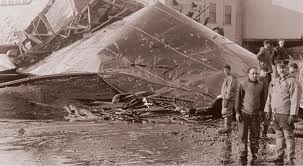

At that point, the tank held enough molasses to fill 3.5 Olympic-sized swimming pools.īoth the inadequate thickness and rivet issues were signs of negligence, and structural engineers knew better at the time, says Rossow. The fourth top-off happened two days before the disaster when a ship arrived from Puerto Rico carrying 2.3 million gallons of molasses. Although molasses had been poured into the container 29 times, only four of those refills were to near capacity.
GREAT MOLASSES FLOOD CORPSE FULL
But its steel walls, which ranged from 0.67 inches at the bottom to 0.31 inches at the top, were too thin to support the weight of a full tank of molasses, found a 2014 analysis by Ronald Mayville, a senior structural engineer in the Massachusetts consulting firm of Simpson, Gumpertz & Heger.įlawed rivet design was another problem, according to Mayville’s analysis, and stresses were too high on the rivet holes, where cracks first formed. Designed to hold 2.5 million gallons of liquid, it measured 50 feet tall and 90 feet in diameter. More recent investigations suggest several fundamental problems with the structure of the tank. Industrial Alcohol, the company that owned the tank, was found liable, even as many questions remained about what had actually happened.
GREAT MOLASSES FLOOD CORPSE TRIAL
The trial that ensued lasted for years and gathered input from thousands of expert witnesses, producing 20,000 pages of conflicting testimony. “Explosion Theory Favored by Expert,” reported the Boston Evening Globe. Some blamed anarchists for setting off a bomb. Have you ever visited Boston? Some say that, on certain days, they can still smell molasses in the North End.In the immediate aftermath, news coverage included speculation about fermentation that produced too much pressure inside the tank.

Following the event, Massachusetts made it mandatory for construction projects to pass inspections from architects and engineers before moving forward. The Great Molasses Flood also shone light on the issue of insecure construction. 125 lawsuits against the company led to it being ordered to pay for damages and loss of human life. As a result, it was too weak to hold the amount of molasses stored in it. When the company built the tank, they cut corners. Instead, an investigation found fault with the USIA. However, this soon proved to be a baseless theory. They said anarchists must have planted a bomb in or near the tank. Initially, the USIA claimed to be the victim of a crime. What happened? What caused this terrible disaster? And, of course, it left everyone with questions. It also killed many horses who had the misfortune of being in its path. The flood had killed 21 people and wounded 150. When the molasses settled, it coated the streets. A train barely escaped the wave as it screeched to a halt ahead of the damaged track. It knocked down buildings, picked up human beings, and even destroyed part of an elevated train track. It raced through the streets at 35 miles per hour, taking out everything in its path. What followed was an enormous wave of molasses. The substance was stored in a huge tank that was 50 feet tall and 90 feet across.Īt about 12:30 p.m., the tank burst. The Purity Distilling Company, part of United States Industrial Alcohol (USIA), had recently received a large shipment of molasses from Puerto Rico. It was just after noon on January 15, 1919. It was an event in which 2.3 million gallons of molasses flooded the streets of the North End of Boston. What was the Great Molasses Flood? Well, it’s just what it sounds like. That year, the city experienced the Great Molasses Flood. Don’t believe us? Just ask anyone who lived in the Boston area in 1919. Others might even wish for a flood of the thick, sugary substance.īe careful what you wish for! A flood of molasses is not as sweet as it sounds. And some kids can’t get enough! Some would ask for a whole vat of molasses. Have you ever tasted molasses? From flavorings to baked goods to candies, molasses has many uses.


 0 kommentar(er)
0 kommentar(er)
